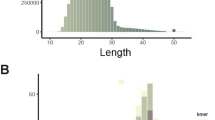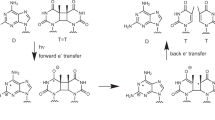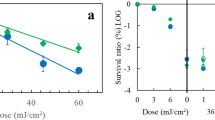Abstract
GREEN plants receive greater exposure to solar ultraviolet radiation and their germ cells (pollen) have a significantly greater potential for acquiring ultraviolet-induced genetic damage than do those of most animals1. Even though cells of the higher plants can photoreactivate ultraviolet damage (refs 2–5, and my unpublished data), the absence of dark-repair capability could be a significant disadvantage since some types of excisable ultraviolet-induced DNA damage are not photo-reactivable6. The capability for dark repair would become even more important if there were an increase in the fluence of solar ultraviolet reaching the Earth's surface7. Attempts to demonstrate excision of pyrimidine dimers in cells of Nicotiana, Haplopappus4, Ginkgo5 and Chlamydomonas8 have all given negative results. These data, taken with other assays for excision repair activity (unscheduled DNA synthesis9; repair replication10–12) have been interpreted as indicating a general absence of such capability in plants12. I have now found, however, that in cultured wild carrot cells, pyrimidine dimers can be excised in the dark and that the extent of dimer excision depends on the initial number of dimers induced by the ultraviolet dose. After ultraviolet fluences of about 10 J m−2, most of the dimers are excised within 24 h; but at fluences up to 30 J m−2, about 25 % remain unexcised in DNA. At fluences above 100 J m−2, dimer excision is almost completely eliminated, perhaps due to secondary effects of these very high ultraviolet doses.
This is a preview of subscription content, access via your institution
Access options
Subscribe to this journal
Receive 51 print issues and online access
$199.00 per year
only $3.90 per issue
Buy this article
- Purchase on Springer Link
- Instant access to full article PDF
Prices may be subject to local taxes which are calculated during checkout
Similar content being viewed by others
References
Swanson, C. P., and Stadler, L. J., in Radiation biology (edit. by Hollaender, A.) 2, 249 (McGraw-Hill, New York, 1955).
Klein, R. M., Physiol. Plant., 16, 73 (1963).
Saito, N., and Werbin, H., Photochem. Photobiol., 9, 389 (1969).
Trosko, J. E., and Mansour, V. H., Radiat. Res., 36, 333 (1968).
Trosko, J. E., and Mansour, V. H., Mutation Res, 7, 120 (1969).
Resnick, M. A., Nature, 266, 377 (1970).
Pollard, E. C., Photochem. Photobiol., 20, 301 (1974).
Swinton, D. C., and Hanawalt, P. C., Photochem. Photobiol., 17, 361 (1973).
Wolff, S., and Scott, D., Expl Cell Res., 55, 9 (1969).
Swinton, D. C., and Hanawalt, P. C., Biochim. biophys. Acta, 294, 385 (1973).
Painter, R. B., and Wolff, S., Mutation Res, 19, 133 (1973).
Wolff, S., and Cleaver, J. E., Mutation Res, 20, 71 (1973).
Rowland, G. P., Hart, R. W., and Yette, M. L., Mutation Res, 27, 81 (1975).
Morowitz, H. J., Science, 111, 229 (1950).
Jagger, J., Radiat. Res., 14, 394 (1961).
Marmur, J., J. molec. Biol., 3, 208 (1961).
Carrier, W. L., and Setlow, R. B., in Methods in Enzymology (edit. by Grossman, L., and Moldave, K.), 21, PtD, 230 (Academic, New York, 1971).
Setlow, R. B., and Carrier, W. L., J. molec. Biol., 17, 237 (1966).
Regan, J. D., and Carrier, W. L., Biophys., J., 8, 319 (1968).
Regan, J. D., and Carrier, W. L., Radiat. Res., 29, 176 (1974).
Zilberstein, A., Arzee, T., and Gressel, J., Cell Differ., 2, 205 (1973).
Zilberstein, A., Arzee, T., and Gressel, J., Cell Differ., 2, 213 (1973).
Cleaver, J. E., in Advances in radiation biology (edit. by Lett, J. T., Adler, H., and Zelle, M.), 4, 1 (Academic, New York, 1974).
Flavell, R. B., Bennett, M. D., Smith, J. B., and Smith, D. B., Biochem. Genet., 12, 257 (1974).
Clayton, D. A., Doda, J. N., and Friedberg, E. C., Proc. natn. Acad. Sci. U.S.A, 71, 2777 (1974).
Soifer, and Cieminis, Dokl. Biochem., 215, 175 (1974) (transl.).
Author information
Authors and Affiliations
Rights and permissions
About this article
Cite this article
HOWLAND, G. Dark-repair of ultraviolet-induced pyrimidine dimers in the DNA of wild carrot protoplasts. Nature 254, 160–161 (1975). https://doi.org/10.1038/254160a0
Received:
Revised:
Issue Date:
DOI: https://doi.org/10.1038/254160a0
This article is cited by
-
Repair mechanisms of UV-induced DNA damage in soybean chloroplasts
Plant Molecular Biology (1995)
-
A simple and sensitive antibody-based method to measure UV-induced DNA damage inZea mays
Plant Molecular Biology Reporter (1993)
-
Evidence for gene transfer by the use of sublethally irradiated pollen in Zea mays and theory of occurrence by chromosome repair through somatic recombination and gene conversion
Molecular and General Genetics MGG (1983)
-
Pollen DNA repair after treatment with the mutagens 4-nitroquinoline-1-oxide, ultraviolet and near-ultraviolet irradiation, and boron dependence of rapair
Molecular and General Genetics MGG (1979)
-
DNA lesions occur with loss of viability in embryos of ageing rye seed
Nature (1978)
Comments
By submitting a comment you agree to abide by our Terms and Community Guidelines. If you find something abusive or that does not comply with our terms or guidelines please flag it as inappropriate.



